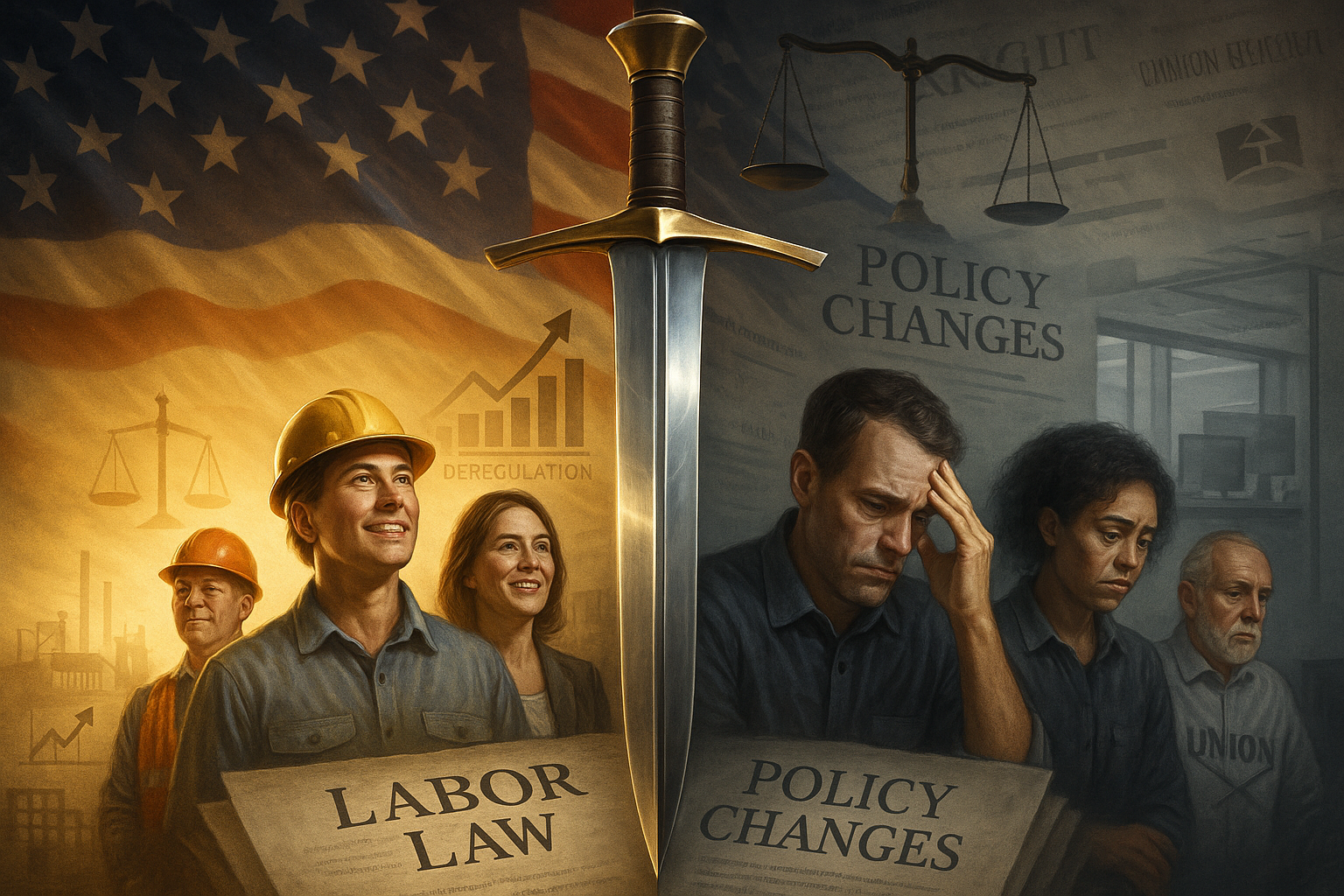The Trump administration's approach to labor laws and regulations was marked by a clear focus on deregulation and a "pro-business" philosophy. These changes have sparked considerable debate, with proponents arguing for economic growth and critics raising concerns about worker protections. Let's delve into some of the key areas of change and explore five potential "pros" and five potential "cons" for American workers, complete with example scenarios.
Understanding the Shift: Deregulation and a Business-Friendly Stance
During his term, President Trump, through the Department of Labor (DOL) and other federal agencies, implemented a series of policies aimed at reducing what his administration viewed as burdensome regulations on businesses. This included executive orders, revisions to existing rules, and strategic appointments to key labor-related boards. The underlying philosophy was that by easing the regulatory load on employers, businesses would be incentivized to grow, innovate, and create more jobs, ultimately benefiting the entire economy.
The "Pros" for Workers: Arguments for Economic Growth and Flexibility
Here are five arguments that suggest these changes could be beneficial for workers, along with example scenarios:
-
Job Creation Through Deregulation:
- Argument: Proponents argue that by reducing regulatory burdens and compliance costs for businesses, companies are more likely to expand and hire more employees. Less red tape translates to more investment in growth, directly leading to new job opportunities.
- Scenario: A small manufacturing company in Houston that previously hesitated to hire due to complex environmental compliance costs finds that new, streamlined regulations make it feasible to open a new production line, leading to 15 new factory jobs in the community.
2. Increased Wages Through Economic Growth:
- Argument: The theory here is that a thriving, less-regulated economy fosters competition and allows businesses to be more profitable. This profitability, in turn, can lead to higher wages and better benefits as companies compete for talent and share their success with their workforce.
- Scenario: An energy company experiences record profits after reduced drilling restrictions. They decide to offer their employees a significant year-end bonus and a 5% raise to retain top talent, directly attributing the success to a more favorable operating environment.
3. Enhanced Flexibility for Businesses and Workers:
-
Argument: Some regulatory changes, particularly those impacting independent contractor classification, aimed to provide businesses with more flexibility in how they staff their operations. This could translate to more diverse work opportunities for individuals seeking non-traditional employment arrangements.
- Scenario: A tech startup finds it easier to hire specialized freelancers for short-term projects without the overhead of full-time employee benefits. This allows them to scale quickly, and the freelancers appreciate the flexibility to work on multiple projects simultaneously.
4. Tax Incentives for Overtime Pay:
- Argument: A specific change made a portion of overtime pay eligible for a tax deduction. This was presented as a direct financial benefit to workers who put in extra hours, effectively allowing them to keep more of their hard-earned money and encouraging productivity.
- Scenario: An experienced electrician working on a crucial infrastructure project puts in significant overtime. Due to the tax deduction on a portion of that overtime pay, he sees a larger net amount in his paycheck, making the extra hours feel more financially rewarding.
5. Reduced Litigation and Compliance Costs:
- Argument: For businesses, a decrease in complex labor regulations could mean less time and money spent on legal challenges and compliance, freeing up resources that could potentially be reinvested into worker training, technology, or other areas that indirectly benefit employees.
- Scenario: A mid-sized logistics company saves thousands of dollars annually on legal fees and HR compliance audits due to simplified regulations. They use these savings to invest in new training programs for their drivers, improving their skills and career prospects.
The "Cons" for Workers: Concerns Over Protections and Standards
Conversely, critics argue that these changes could have detrimental effects on workers' rights and well-being, along with example scenarios:
-
Weakened Worker Protections:
-
Argument: Many of the rolled-back regulations were designed to protect workers from exploitation, unsafe conditions, or unfair labor practices. Critics argue that easing these rules leaves workers more vulnerable and erodes hard-won protections.
- Scenario: A construction worker on a large building site notices that safety protocols, previously strictly enforced by federal guidelines, have become lax, leading to an increase in minor accidents because the company faces less scrutiny.
-
Argument: Many of the rolled-back regulations were designed to protect workers from exploitation, unsafe conditions, or unfair labor practices. Critics argue that easing these rules leaves workers more vulnerable and erodes hard-won protections.
2. Suppression of Wages and Benefits:
-
Argument: Changes to minimum wage laws for specific sectors or efforts to reclassify employees as independent contractors can potentially lead to lower wages, reduced access to benefits (like health insurance or retirement plans), and a lack of protections like unemployment insurance.
-
Scenario: Home healthcare providers, previously covered by certain minimum wage and overtime rules, find that a reinterpretation of their employment status means they are no longer eligible for these protections, leading to a decrease in their overall take-home pay and no health benefits.
3. Decreased Workplace Safety:
-
Argument: Efforts to revise or eliminate regulations related to workplace safety and health could expose workers to greater risks of injury or illness. Reduced enforcement of these standards could lead to less safe working environments.
- Scenario: Workers in a chemical plant notice that the frequency of safety inspections has decreased, and a new rule makes it easier for the company to appeal citations for minor safety violations, leading to a less vigilant approach to potential hazards.
4. Erosion of Union Power:
- Argument: Appointments to the National Labor Relations Board (NLRB) often shifted the balance towards employers, making it more challenging for unions to organize, bargain collectively, and protect workers' rights. This can limit the collective voice of employees in advocating for better conditions.
- Scenario: Employees at a large retail chain attempt to unionize for better pay and working conditions, but a recent NLRB ruling makes it significantly harder for them to form a bargaining unit, dampening their efforts and leaving individual workers with less leverage.
5. Uncertainty and Instability:
- Argument: Frequent changes to labor laws and a shift in enforcement priorities can create an environment of uncertainty for workers. This instability can make it difficult for employees to understand their rights and protections, potentially leading to less secure employment.
- Scenario: A worker who has spent years planning their retirement based on current benefit laws suddenly faces the possibility of those laws changing, creating anxiety and uncertainty about their financial future.
Fortify This!
The debate surrounding labor law changes often boils down to a fundamental tension: the pursuit of economic growth versus the protection of individual workers. While proponents of deregulation champion the idea that a less restricted business environment will inevitably "lift all boats," critics argue that a rising tide without strong guardrails can leave the most vulnerable workers stranded or even capsized.
Moving forward, the challenge for any administration is to find a balance that fosters a dynamic economy while simultaneously ensuring that workers are treated fairly, paid adequately, and operate in safe environments. Fortifying our labor laws isn't just about adding more rules; it's about building a resilient framework that can adapt to changing economic landscapes without sacrificing fundamental worker rights. This means ensuring that "flexibility" doesn't become a euphemism for exploitation, and that "efficiency" doesn't come at the cost of human well-being. It requires ongoing dialogue between businesses, labor organizations, and policymakers to craft regulations that are clear, enforceable, and ultimately serve the interests of both a prosperous economy and a thriving workforce. It also demands a commitment to robust oversight and swift action against those who seek to circumvent fair labor practices, regardless of the political winds.



0 comments